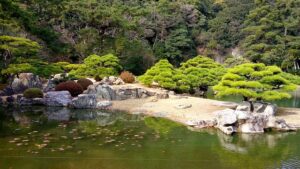Stargazing is one of the best things to experience in Sedona. Nestled in the heart of red rock country, Sedona is famous not just for its stunning landscapes and spiritual vibes but also for its prime spot for celestial wonders.
If you’ve ever dreamed of lying under a blanket of stars, then Stargazing in Sedona is something you must explore.
Stargazing in Sedona: Best Spots & Tips Under the Red Rock Sky
Why Stargazing in Sedona is so famous?
So, what makes Sedona such a stargazing paradise? First off, the skies here are dark, really dark. Sedona is located in a designated Dark Sky Community, meaning there’s minimal light pollution, making it an ideal location for astronomy lovers.
The vast open spaces, clear air and elevation (about 4,300 feet above sea level) contribute to the crisp, vibrant night skies.
Not only does the darkness reveal thousands of twinkling stars, but the unique backdrop of red rock formations adds a mystical element to the whole experience.
Imagine the jagged silhouettes of the rocks framed against the Milky Way, or the distant glow of a far-off planet casting a subtle light across the landscape. It’s otherworldly.
Best Spots for Stargazing in Sedona
1. Airport Mesa
Airport Mesa is one of Sedona’s most popular spots for stargazing, and for good reason. Not only do you get a panoramic view of the town, but you’re also treated to an unobstructed view of the night sky.
It’s an easy drive to the top, and once you’re there, you’ll be able to spot constellations, planets, and maybe even the occasional shooting star. Plus, the 360-degree views of the red rock formations are stunning, making it a perfect place to relax and soak in the beauty of both the earth and the sky.
2. Red Rock State Park
If you’re looking for a more immersive stargazing experience, Red Rock State Park is a great option. With designated stargazing events throughout the year, the park offers guided tours where experts help you navigate the constellations and teach you about the night sky.
The park’s remote location means you won’t have to worry about city lights interfering with your view. Bring a blanket, grab a hot drink, and settle in for an unforgettable evening.
3. The Chapel of the Holy Cross
This architectural marvel, built right into the red rock formations, offers another killer view of Sedona’s night sky. While the chapel itself is a place of reflection and beauty, the area surrounding it is a peaceful spot for stargazing.
You won’t find a crowd here, making it a serene and almost spiritual way to connect with the stars above.
4. Vortex Sites
Sedona is known for its “vortex” sites, areas that are believed to have unique energy that draws people seeking spiritual experiences. While these sites are often visited during the day, the quiet calm of night adds a whole new dimension.
Visit one of these sites after dark for an otherworldly experience where the energy of the earth and sky seem to combine.
Best Thing About Stargazing in Sedona
The clear skies over Sedona offer plenty of celestial delights. The Milky Way is one of the most awe-inspiring sights, stretching across the sky like a glowing ribbon.
During the right time of year, Sedona is also perfect for catching meteor showers, especially the Perseids in August.
The planet Venus, often visible just after sunset or before sunrise, is a fan favorite, while Jupiter, Saturn and Mars are frequent visitors.
Tips for Stargazing in Sedona
1. Bring a Red Flashlight:
Regular flashlights can ruin your night vision, but red lights are less disruptive to your ability to see the stars.
2. Dress Warmly:
Even in the warmer months, Sedona can get chilly at night. Bring a jacket, blanket, and maybe even some warm layers to stay comfortable.
3. Plan for the Right Time:
The best time to stargaze in Sedona is during the new moon when the sky is darkest. Check a lunar calendar to plan your trip accordingly.
4. Look for Events:
Many local groups and observatories offer stargazing tours, where you can learn about constellations and use telescopes to get a closer look at planets and deep space objects.
5. Best Time to Stargaze:
The best time to stargaze in Sedona is typically during the new moon phase when the sky is darkest. You’ll want to get there after the sun sets, which varies by season, but generally anytime between 8 PM and midnight is prime stargazing time.
6. Preparation:
Bring warm clothing, a red flashlight (to preserve your night vision), a blanket or comfortable chair, and maybe some snacks and hot drinks. Don’t forget a camera if you want to capture the magical views. Also, check the lunar calendar for the best dates during a new moon.
7. Stargazing Locations:
Popular stargazing locations include Airport Mesa, Red Rock State Park, The Chapel of the Holy Cross, and various vortex sites. These areas provide dark skies and excellent vantage points for spotting constellations and planets.
8. Stargazing Events:
Sedona hosts a variety of stargazing events, including guided tours, educational programs, and community nights. Red Rock State Park, for example, holds special stargazing events, and the Sedona Observatory offers viewing sessions with telescopes.
Conclusion
Stargazing in Sedona isn’t just about looking up, it’s about feeling connected to the universe.
Whether you’re here for a relaxing getaway, a spiritual retreat or an adventure in the great outdoors, Sedona’s night sky offers an unforgettable experience.
The stars are waiting. Are you ready to look up?
FAQs =》
Q1. Are there stargazing tours available in Sedona?
Ans. Yes. There are several guided stargazing tours available, where you can learn about the constellations, planets, and deep-space objects. Some tours even offer the use of telescopes for a closer look at the night sky.
Q2. Is it necessary to bring equipment for stargazing?
Ans. While you don’t need any specialized equipment to enjoy the stars, bringing a good pair of binoculars or a telescope will enhance your experience. If you prefer to just relax and enjoy the view, you can simply bring a blanket or chair.
Q3. Is Sedona good for stargazing year-round?
Ans. Yes. Sedona is a great place to stargaze throughout the year. Summer offers warm nights, while winter’s cooler temperatures provide clearer skies. Each season brings something unique, but Sedona’s clear skies and dark nights are a constant.
Q4. Can I see the Milky Way in Sedona?
Ans. Yes. Sedona’s dark skies offer incredible views of the Milky Way, especially during the summer months when it’s visible in the night sky. The red rock formations provide a stunning backdrop to this celestial wonder.
Q5. Is there a lot of light pollution in Sedona?
Ans. No, Sedona is a designated Dark Sky Community, which means light pollution is minimal. The city and surrounding areas have taken steps to reduce artificial lighting, making it a perfect place to enjoy clear, dark skies.
Q6. Can I stargaze in Sedona during the day?
Ans. While you won’t be able to see stars during the day, Sedona’s daytime views are just as beautiful with its red rock formations and vibrant landscapes. Stargazing is a nighttime activity, so plan to visit after the sun sets for the best experience.


